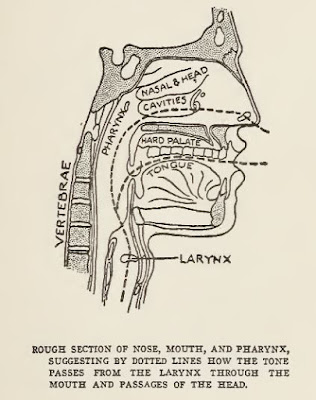« (...) it is usual to instruct the pupil to sing "forward", "dans le masque" (in the mask), and so on, but it should be clearly understood that though such terms are useful from the practical point of view, they are none the less only a "façon de parler", and a means of instructing the pupil how to adjust and adapt the whole vocal apparatus, so to speak, in the most effective way. (...)
Some fortunate ones, like myself, have voices which are quite perfectly placed by Nature. (...) In the vast majority of cases, however, the pupil's voice is not naturally placed so as to give the best results. That is to say, by proper instruction and training it can be made to produce better results—tones more smooth, more sound, more resonant, and so on—and it is here that the services of an experienced and capable teacher are beyond price. »
« (...) si è soliti istruire l'allievo a cantare "avanti", "dans le masque" (in maschera), e via dicendo, ma andrebbe capito con chiarezza che sebbene tali termini siano utili dal punto di vista pratico, ciò nonostante sono solo un "façon de parler" (modo di dire), e un mezzo per istruire l'allievo ad aggiustare ed adattare l'intero apparato vocale, per così dire, nel modo più efficace possibile. (...)
Alcuni fortunati, come me, possiedono voci che sono già perfettamente posizionate per Natura. (...) Tuttavia, nella stragrande maggioranza dei casi la voce dello studente non è naturalmente posizionata in modo da dare i migliori risultati. Vale a dire, con un'istruzione e una formazione adeguate si può ottenere di produrre risultati migliori—suoni più armoniosi, maggior suono, più risonante, e così via—ed è qui che l'assistenza d'un insegnante esperto e capace non ha prezzo. »
(dal capitolo "Placing the voice" del libro "How to sing" di Luisa Tetrazzini pubblicato nel 1923)








Nessun commento:
Posta un commento